
When I was a kid, they built a bridge in my back yard.
The Verrazzano-Narrows Bridge was built in five years between 1959 and 1964. Prior to that, there was no way to reach Staten Island from any other part of NYC except by boat. Ironically, you could reach Staten Island from the mainland via 3 bridges, the Goethals, Bayonne and the Outerbridge. Staten retained very much a small town feel despite these two bridges, though, since a bridge connection from NYC and one from Union County, New Jersey are two separate stories. Staten Island would reap immediate benefits from the new bridge, but Brooklyn would incur immediate losses.
 Several of the images on this page were used in the Brooklyn Historical Society’s “Experience Beauty Suspended” featuring the construction of the Verrazzano-Narrows Bridge. The exhibit runs from November 19th, 2004 to March 20, 2005.
Several of the images on this page were used in the Brooklyn Historical Society’s “Experience Beauty Suspended” featuring the construction of the Verrazzano-Narrows Bridge. The exhibit runs from November 19th, 2004 to March 20, 2005.
From the now-deleted BHS website: “The exhibit explores the many political and engineering hurdles that had to be overcome for the bridge to be built. Features of the exhibit include the stories of two giants of twentieth-century bridge-building: master builder Robert Moses and master bridge engineer Othmar Hermann Ammann, as well as the thousands of workers who actually built the bridge. The exhibit will include photographs, paintings and memorabilia from the Brooklyn Historical Society’s permanent collection as well as the contributions of Bay Ridge residents who were impacted by the bridge’s construction. The oral history section of the exhibit includes two films featuring the personal stories of the workers who built the bridge and members of the communities affected by its construction. Additional exhibit highlights include photographs, original drawings and watercolors, historic reports, prints, models, a section of bridge cable, and memorabilia from Opening Day, November 21, 1964, drawn from the collection of the MTA Bridges and Tunnels Special Archive.”
There were long and voluble protests from Bay Ridgers when plans for the bridge were announced. NYC’s master builder, Robert Moses, planned to scythe the long, wide bridge ramp through the heart of the neighborhood in a strip along 7th Avenue. Moses usually got what he wanted, though his plans to build a Battery Bridge and the Brooklyn Queens Expressway through Brooklyn Heights had been derailed and a concurrent plan to build the Lower Manhattan Expressway along Broome Street would eventually be. There was no such reprieve for Bay Ridgers, and fully 7000 residents were displaced.
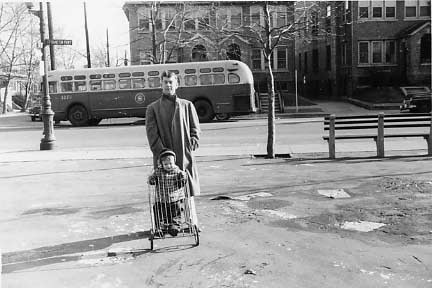

These two pictures, both from 1960, show the progress the city made in eliminating the buildings along Fort Hamilton Parkway. Every street between 65th and 92nd Street, as well as 7th Avenue, saw hundreds of homes torn down. Our home was across the street from a triangle-shaped park formed by the intersection of Ft. Hamilton Parkway, 6th Avenue and 83rd Street…just missing the red zone. One problem was that the city, once having torn the buildings down, retained acre after acre of empty lots before construction began. Rats and vermin became a problem.
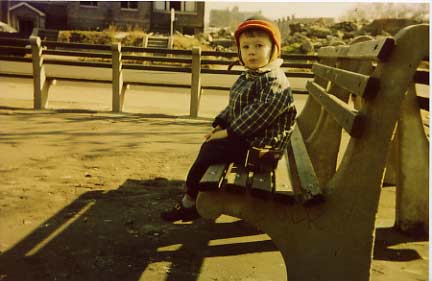
Contrary to what Calvin‘s father used to say, the world DID turn color before 1966. Before the Gowanus Expressway replaced all the buildings across the street, this park was pretty much an uneven concrete surface with the only amenities being splintering wooden benches. You can also tell that the graffiti plague was just getting started. Recently, this park, now the Tom McDonald Triangle (I doubt for the NY1 sportscaster) has been given trees, plants and new seats. Springs and summers, my mother would sit in this park with her friends each night until 8:30, until they all went in. That was when Merv came on, you see.

When I was a kid, General Motors buses in two shades of green still worked the Brooklyn streets, abetted by two-tone Mack buses. (A GM can also be seen in the photo above left). They were still going, on some routes, until the early 1970s (Above 1972 photo on Jay Street and Myrtle Avenue by Steve Zabel from nycsubway.org). The Myrtle Avenue El had been discontinued and dismantled in 1969. This section of Myrtle Avenue is now a part of the Metrotech campus.


Under the eagle eyes of construction supervisor John “Hard Nose” Murphy, thousands of “boomers” or itinerant construction workers along with native NYC bridge workers, erected the iron and steel and strung the cables. In these two pictures from October 1963, the center of the bridge deck was put in place first. The deck consisted of 60 separate 400-ton pieces, lifted into place from barges. Each piece was one of a kind and were alike down to the millimeter.

In this 1963 photo the cables are visible through the incomplete bridge anchorage. Cable spinning began in March 1963 as four 48″ spinning wheels would be spun constantly, carrying two wires at once. Workers along catwalks would grab the wires and clamp them to specified hooks along the length of the bridge. Wires would then be bunched into 4 cables which would eventually weigh about 9270 tons apiece. Amazingly, the workers on the catwalks worked without nets at first, until three fatalities prompted a job action after which nets were provided. I would watch the spinning wheels slowly make their way back and forth on the bridge in the summer of 1963.
Despite what Tony Manero told Stephanie in Saturday Night Fever, no worker ever fell into the unset concrete in the bridge anchorage and drowned; it’s just an urban legend.

Kids play before an as-yet-undecked Verrazzano-Narrows Bridge in 1962. In those days, dads wore ties and moms wore their high heels to take the kiddies to the playground.

In early 1963 most of the deck and cables are in position.

In a few months, much of the deck has been put in position except for a short space near the tower.


At length, after a couple of years, the residents had been moved out and paid off, and the homes and apartment buildings demolished. Steam shovels and dump trucks moved in and began the arduous task of moving tons upon tons of real estate to make way for the Gowanus Expressway. In the above two shots, Ft. Hamilton Parkway is in the right background, while Sixth Avenue, and our apartment house, are on the left. The photos are from mid-1963. Seventh Avenue would begin a new role as the service road on either side of the expressway and the three homes on the right would wind up on 7th Avenue instead of FHP. By the way, once the “new” 7th Avenue was finished was also the first time I saw the new vinyl/aluminum Brooklyn black and white street signs, which made their debut in 1964.

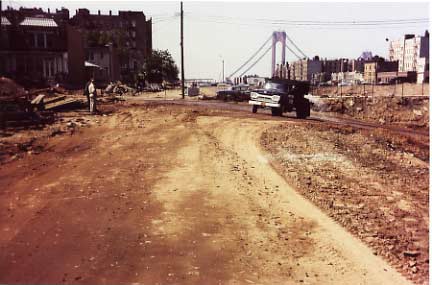
Above: a Gull Contracting Co. vehicle shovels earth. Below: The Gowanus Expressway is cleared out at 84th Street. 84th has not yet been closed: the telephone pole in the center of the picture marks its presence. At the left in the photo, some debris from the razing has yet to be cleared, while the Verrazzano-Narrows Bridge rises in the background.
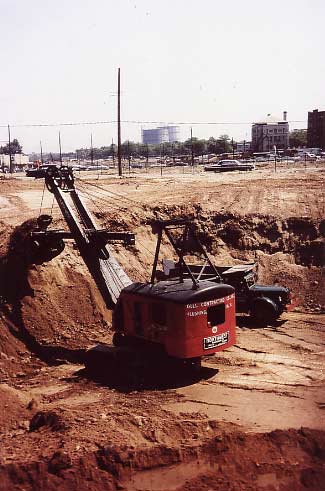
Looking east. The two gas tanks were along 65th Street and didn’t survive the 1980s, while the public school at right barely avoided the red zone and still stands.

The trench gets deeper. 83rd Street, marked by the line of cars and telephone poles, has not yet been closed. The expressway now serves as a moat with only a few streets, such as Ovington Avenue, Bay Ridge Parkway and 86th Street being allowed to pass.


In about a year’s time the expressway was finished and things began to pretty much look as they do today. In the fall of 1964, before the official bridge opening, only the cops, city and DOT officials were allowed on, but that didn’t mean some curious kids couldn’t check things out, as the picture at right shows. The massively wide Gowanus Expressway was built all the way to the Brooklyn Battery Tunnel, on 3rd Avenue replacing an earlier structure that had served as the old Fifth Avenue Elevated line (the trains had rumbled down Third Avenue in Sunset Park). Today (2003) there is talk of putting the Sunset Park section in a tunnel, but after Boston’s cost overruns in the Big Dig debacle, that scenario isn’t likely–especially in an “outlying” neighborhood.
On Saturday, November 21, 1964 the blood, sweat and tears were over and it was time to open the bridge. By this time, Brooklynites had pretty much reconciled themselves to the massive new addition. It was a gala day, albeit a very cold one for November, with the temperature reaching the mid 30s with a cold wind. Mayor Robert Wagner, Robert Moses and other officals held forth and cut the usual ribbon. Moses, however, forgot to mention the bridge’s chief architect: the great Swiss engineer Othmar Ammann! A gaggle of antique cars was first across the bridge, followed by thousands of other cars and buses, one of which carried your webmaster and his parents.


Bay Ridgers wait in the cold for a GM two-tone. Meanwhile, a busy cop directs traffic at 92nd Street and Ft. Hamilton Parkway at the main bridge entrance –where there wasn’t a stoplight! One problem engineers dealt with only middling success was that it was hard to get traffic to the bridge through Bay Ridge’s narrow streets. The approaches are in the oldest part of town where the streets are narrowest. 92nd Street expands from two lanes to four at this point.


Meanwhile, if you weren’t crossing the bridge, you were watching people cross. Throngs gathered in the park along The Narrows as bands played and fireboats sprayed.
Taken from the bus crossing the bridge on opening day. Interestingly, though Robert Moses refused to allow pedestrians or bicyclists on the bridge (the hooligans!) these pictures reveal there was ample space for a sidewalk. Over the years, various boards and panels have investigated the possibilty of including space for non-motorized traffic. Higher fencing and greater security would be needed. Just do it already!
On November 22, 1964, the Bay Ridge-St. George, Staten Island ferry went out of business after almost a century’s service–a day after the bridge opened.

The Belt Parkway on November 21, 1964. Since the Belt hugs the coast, it’s impossible to drive directly onto the VNB from the Belt. You are obliged to exit at 4th Avenue and use the 92nd Street entrance. Through a large ramp, however, you can enter the Belt from the bridge.
Today, the Belt Parkway looks much the same, except that the wood lampposts have been removed. Woodies were placed on all of Moses’ parkways beginning in the 1930s to impart a rustic, countrified look. By the Swingin’ Sixties, pretty much all the rurality in the areas served by the parkways had pretty much gone, so the Woodies have by now been replaced by cylindrical highway poles.
Though I got my share of toys as a kid — I was an only child –I really didn’t need a whole lot of them. For some reason, as a kid I was absolutely obsessed with lampposts. My folks would buy writing tablets for me so I could draw them. When going for a ride on the bus, I would take along a plastic spoon, a pencil and one of those little lightbulbs that came in flash lights, and make my own lampposts. When we went under a bridge, my hand would stand in for the bridge. When they were building the Gowanus, I would play in the dirt, smoothing it out, building my own highway.
I was very self-contained as a child and remain so today.
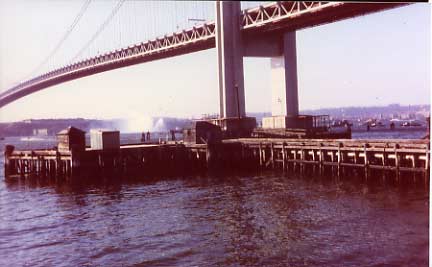
The Denyse Wharf in 1964. The Denyse family is an ancient Bay Ridge family with roots going back to the Revolution and previous. The family operated a ferry as well as this wharf, formerly a part of Fort Hamilton before the Belt Parkway severed the connection about 1940. 101st Street was formerly called Denyse Street.


Passage on the bridge cost 50 cents each way on opening day. The current (as of 2012) toll for cars on the Verrazzano-Narrows Bridge is $13.00 cash (without E-ZPass) and $9.60 with E-ZPass. Tolls are collected only from vehicles traveling from Brooklyn to Staten Island.
Forgotten Fan Joseph Schlesinger sent these bridge toll receipts from Day One.

The just-completed bridge. The Brooklyn tower stands on the former site of Fort Lafayette.

Vintage cars approach the Verrazzano on opening day.
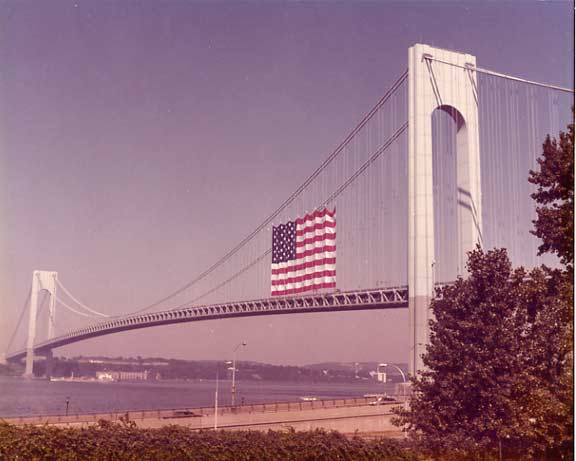
On June 28, 1976 the largest American flag in the world to date was placed on the Verrazzano. It lasted a few minutes before winds tore it apart. (Technology wasn’t quite as advanced then). Since then a bigger flag was produced in Thailand, but we’re told an even larger flag was produced in the USA. Help me out, Forgotten fans!
Forgotten Fan Paul Toomey:
The Great American Flag, the largest flag made at that time, measured 193′ by 366.5′ It weighed about 1-1/2 tons and was over 70,000 square feet or one and a half times the size of a football field. It was 13 times the size of the flag that hangs [at times] above the roadway of the George Washington Bridge. The flag’s stars were 11′ in diameter and the stripes were 15′ wide. It was sponsored by Arm & Hammer and donated to the City of New York as a Bicentennial gift. The flag was manufactured by Hood Sailmakers inc. and the Annin Flag Company. It was to be unfurled on July 3 and July 4 as an integral part of “Operation Sail.” It was unfurled on the 28th of June as a test run and the winds forced it against the support cables where it ripped to pieces never to be seen again. The photograph was taken from Fort Hamilton by Mr. Robert Cranston, since deceased. Many of the local businesses, banks, law firms etc. displayed framed copies of the original photograph. I was lucky to have seen the flag before it was torn apart.
Mere pedestrians were finally allowed on the bridge in early October 1989 as the VNB celebrated its 25th anniversary. This was also a very cool day. The sun was so bright, it almost hurt. Danny Aiello, fresh from getting his pizzeria trashed in Do The Right Thing, passed me on the bridge. He was a large man and walked quickly.
Will lowly pedestrians ever be vouchsafed a walk on the bridge ever again? Bridges are likely to be targets in the Age of Terror.
The Verrazzano-Narrows Bridge wasn’t finished in 1964. Only the top deck was ready for traffic; the second deck, where, disappointingly, most of the buses go, was supposed to open in 1975 but opened in June 1969 because of heavy bridge traffic.
Sources:
The Bridge, Gay Talese, Harper & Row 1964
BUY this book at Amazon.COM
The Bridges of New York, Sharon Reier, Yale University Press 1977
BUY this book at Amazon.COM
Six Bridges: The Legacy of Othmar Ammann, Darl Rastorfer, Quadrant Press 1977
BUY this book at Amazon.COM
Steve Anderson, nycroads.com
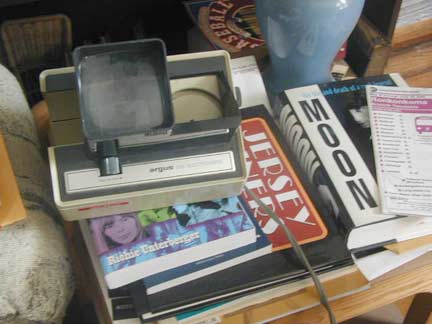
Most of the pictures on this page were taken by my father or mother and were preserved in slide form. So, they were hard to see until I rescued this handy-dandy Argus Electro-Matic slide viewer from the scrap heap. Till 2005 I didn’t use a cell phone and I had no need for blackberries, PDAs or IPods, but I did have the Electro-Matic, and my Sony Watchman, a walkie-watchie, did the trick during that recent blackout.
Visit photographer Dave Frieder’s site for terrific views from the top of the VNB and other bridges
8/17/2003; revised 2012


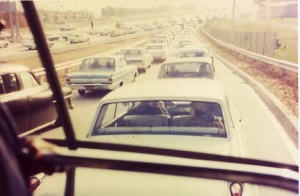
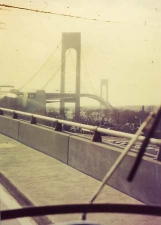
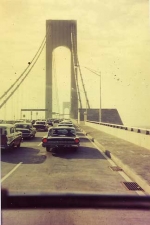
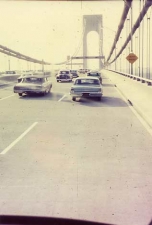
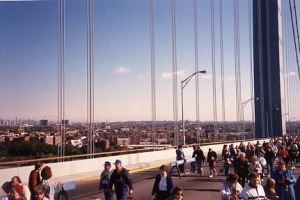
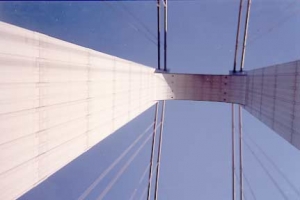
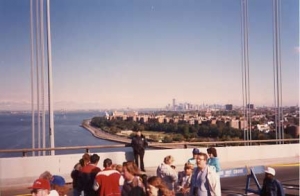
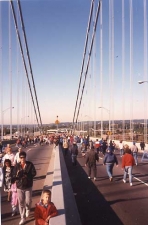
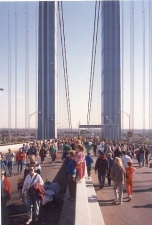
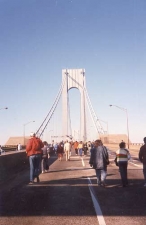
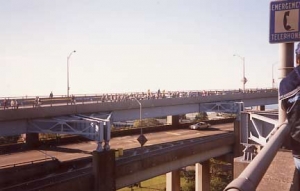
20 comments
i remember that bridge being built as well as the ferry that ran before it was built
The steel for the bridge came from harris steel in south plainfield n.j. I saw that bridge being built quite oftenas well as the wtc as dad worked for the port authority and cousins lived in bay ridge.
Family had moved to nj during that time. I was inducted into us navy at fort hamilton….
I left on a ship for service in Germany in August 1963. The two towers were the only thing constructed so far. Came back March 1965 and what a sight it was all finished up. My first trip over it was by mistake coming back from hot dogs at Nathan’s and not realizing right hand lane was bridge only.
I remember my dad taking me to see it being built when I was 8 years old. We lived in NJ.
The day the flag was placed on the bridge I was stationed in the Coast Guard at Brooklyn Air Station. I was a crew member on a Coast Guard helicopter that day in June 1976. We flew out to see the flag just as it was starting to rip from the wind. I was 21 years old at the time.
Thanks for the memories with your website, stories, and pictures.
My dad and 2 older brothers worked on the bridge running cables. They were members of local 197 bridge, structural and ornamental iron workers.
What memories! Was 19 years old and lived on Fort Wadsworth, Staten Island, my dad was stationed there. After already having visited “the office” looking for a job, I received a call one afternoon to report for work next morning. I flat out lied about my experience working at heights and never will forget my first day when we didn’t take the elevator to the top but walked almost straight up from the backside of the tower; got used to the height real quick. Still, I never lost my respect for the precariously spaced rail cables running along the sides of the catwalk (600 feet, straight down. Worked the remaining months of the cable spinning operation in 1963 with a Blackfoot Indian just off the Staten Island tower (US Steel?). Never joined any union that I was aware of but do remember that I had union dues deducted from my paycheck. Always wondered how I ever managed to get that job, but now in my old age I think the “super” put me on, knowing someday I would have something to talk about.
I recall the 69th street ferry to S.I. WHEN WE WENT TO VISIT OUR RELATIVE . MY DAD DROVE THE CAR RIGHT ONTO THE FERRY AND ALWAYS LET MY BROTHER AND I GET A SUN DEW DRINK IN A RECTANGED WAX CONTAINER AND A SALTY SOGGEY PRETSLE WHICH WAS ALWAYS SOGGEY FROM THE OCEAN BEST PART OF THE TRIP TO VISIT OUR RELATIVES IN S.I. GARY AYD
I was master of the container ship SS sealand market inbound for Port Elizabeth,New Jersey passing under the bicentennial American flag on the verrazano bridge shortly before the flag was torn to shreds by the wind.It was such a awe inspiring sight and I think of that day often.If anyone has any photos of my ship passing under the bridge on that memorable day I would greatly appreciate hearing from you.My email address as follows. Captkurk24@aol.com. Cell phone number 484 994 9298.
Thank you and your parents for the photo preservation and history lesson. I lived on 15th Ave at Bath Ave when born in 1967 until 1980 and indeed this was the Bridge in the Backyard. What a gift this was to me tonight.
My favorite veiw Verrazzano Narrows
From rosebank statenisland
Thanks for the memories.
I LIVED AT22GATLING PL 1953-56MY FATHER WAS A CONSTRUCTION FOREMAN.WHEN THE BRIDGE WAS GOING UP WE LIVED ON 7 AVE BETWEEN 84 & 85ST. MY FATHER WAS A FOREMAN ON THE BRIDGE AND I WENT TO WORK THERE AFTER GRADUATING H.S. AS A coffee boy.,Very exiting Experience
I lived on 67th street and 7th Avenue and we had to move. We moved to Staten Island and I remember taking the Brooklyn 69th street ferry to and from Staten Island.
I watched the Brooklyn tower of the Verrazzano Bridge go up from homeroom class at New Utrecht HS in the early 60’s. I commuted to Wagner College on Staten Island via the 69th Street ferry in the fall of 1964. It was a long 2 hours each way. Coming home on the Friday before the bridge opened, I had a premonition that it might be my last ferry ride. Sure enough the gangplank opened on Saturday, the ferry shutdown on Sunday, and beginning Monday I was taking either the Fort Hamilton Pkwy bus or the 4th Avenue subway to get the R7 bus over the bridge. It shortened my commute by 1/2 hour.
My dad worked on that bridge before he died in 1960. He worked for Horn Construction and I remember the story of the kids that were playing in the pile of sand and some of them died. My dad was there and helped pull some of them out.
I don’t mean to nitpick – I’d have sent you a private message on FNY’s Facebook page, but I couldn’t find that option available – hence this public post.
If the reference to the source of some of the photos used is from a 16-year-old museum exhibit, it should say “The exhibit ran from November 19th, 2004 to March 20, 2005,” not “The exhibit runs…” as it presently does.
Excellent pick
In 1964 I was working on the bridge as a coffee boy or runner .my father was a general foreman and my brother a worker .we were able to drive across to staten Island on our way to NJ as early as August 64 I bet my dog was the first dog to cross.we lived on 7 Ave between 84 and85 st .I miss old bay ridge
You can drive up to the bridge from the westbound Belt Parkway using that large looping ramp, the one that takes you down to the eastbound side after you’ve crossed the bridge. It’s a two-way ramp.
The bus appears to be a Mack ?